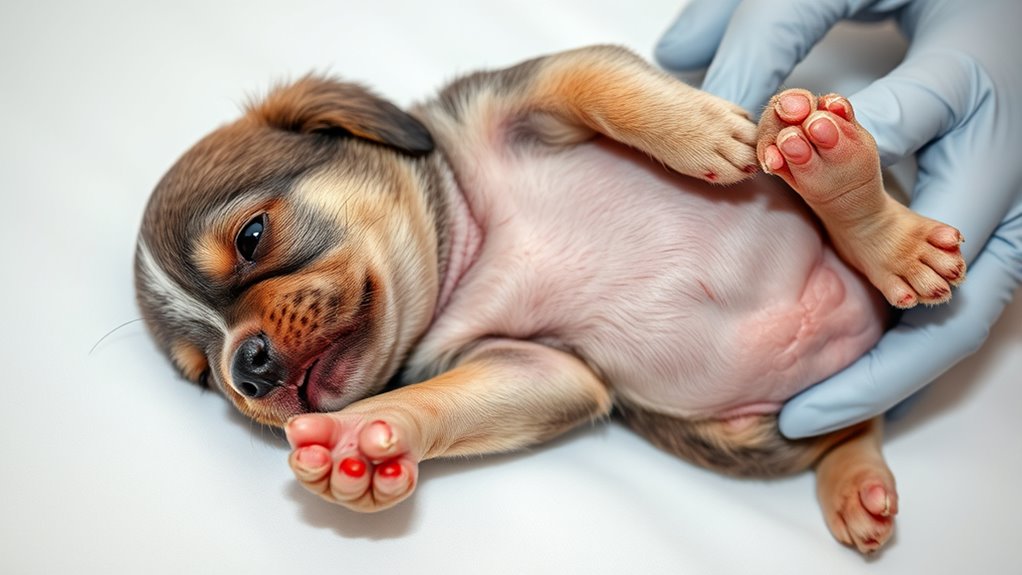If you notice your dog losing interest in food, vomiting, or having watery, foul-smelling diarrhea—sometimes with blood—these could be early signs of canine parvovirus. Fever, lethargy, and rapid symptom development also point to trouble. Keep a close watch on any sudden behavioral changes, and contact your vet immediately for diagnosis and treatment. Staying vigilant now can make all the difference—continue exploring to learn how to protect your pup.
Key Takeaways
- Watch for sudden loss of appetite, vomiting, and watery or bloody diarrhea, which are early signs of parvovirus.
- Monitor for fever, lethargy, and decreased activity, indicating possible infection.
- Prompt veterinary attention is crucial if symptoms appear, to improve treatment outcomes.
- Keep detailed records of symptom progression to assist your vet’s diagnosis.
- Early detection combined with vaccination and hygiene reduces the risk of severe illness.

Canine parvovirus is a serious, highly contagious illness that can quickly become life-threatening if not caught early. Recognizing the early signs is crucial, and vaccination importance cannot be overstated—vaccinating your puppy is your best defense against this deadly virus. Proper vaccination schedules help build immunity, reducing the risk of infection, but even vaccinated dogs should stay alert for symptoms. Once infected, the virus attacks rapidly dividing cells in the intestines and bone marrow, leading to severe dehydration, weakness, and other complications. Being vigilant about early indicators can save your dog’s life.
Canine parvovirus is highly contagious and deadly without early detection and vaccination.
Initially, you might notice that your puppy loses interest in food and water, a sign that something isn’t right. Vomiting and diarrhea often follow, with the stool sometimes containing blood or appearing extremely watery and foul-smelling. These symptoms can develop quickly, sometimes within days of exposure. Fever, lethargy, and a sudden decrease in activity level are also common early signs. If you observe any of these, don’t delay—prompt veterinary attention is essential. Early diagnosis and treatment considerably improve the chances of recovery.
Home care tips can help you manage your dog’s comfort and monitor progress if you suspect parvovirus. Keep your puppy in a warm, quiet space away from other pets to prevent spreading the disease and to reduce stress, which can weaken their immune system further. Make sure they stay Hydrated—offer small amounts of water frequently, but never force them, as vomiting can make this risky. Your vet might recommend electrolyte solutions to help replenish lost minerals. It’s essential to follow your vet’s guidance on feeding; in some cases, withholding food initially might be recommended until vomiting subsides, then gradually reintroducing bland, easily digestible meals.
Monitoring your puppy closely during this period is essential. Watch for worsening symptoms such as persistent vomiting, bloody diarrhea, or signs of pain, like whining or restlessness. Keep a log of their behavior and symptoms, and communicate these details clearly with your vet. Remember, early intervention is your best tool—delaying treatment can lead to severe dehydration, sepsis, or death. In addition to medical care, maintaining good hygiene and disinfecting your environment helps prevent the spread of the virus. Regularly cleaning and disinfecting surfaces, especially if your puppy has been exposed or shows symptoms, minimizes the risk for other pets. Understanding the importance of vaccination, recognizing early signs, and providing attentive home care are your best strategies for protecting your puppy from canine parvovirus. Acting quickly and following your veterinarian’s advice can make all the difference between a full recovery and a tragic outcome.
A key aspect of managing infectious diseases like parvovirus is proper hygiene practices that help reduce environmental contamination and prevent further spread.
Frequently Asked Questions
Can Older Dogs Show Early Signs of Parvovirus?
Older dogs can show early signs of parvovirus, especially if their vaccination schedule isn’t up to date. Keep an eye out for symptoms like vomiting, diarrhea, and lethargy. Dietary considerations matter too, as a weakened immune system can make them more vulnerable. If you notice these signs, consult your vet immediately to guarantee proper diagnosis and treatment, even in senior dogs.
How Long Before Symptoms Appear After Infection?
Timing takes time. After infection, the symptom timeline typically begins with a short incubation period of 3 to 7 days. During this window, your dog might seem fine, but the virus is quietly multiplying. Symptoms usually surface suddenly after this period, including vomiting, diarrhea, and lethargy. Knowing the incubation period helps you understand when signs will likely show up, so you can act swiftly and seek veterinary care.
Are There Breeds More Resistant to Parvovirus?
You might wonder if some breeds are more resistant to parvovirus. While breed susceptibility varies, genetic resistance plays a role in how well certain dogs can fight the virus. For example, some breeds like Dobermans are more vulnerable, whereas others may have a natural advantage. However, vaccination remains essential for all breeds, as it considerably reduces the risk, regardless of genetic resistance or breed susceptibility.
Can Mild Symptoms Indicate Early Parvovirus?
Mild symptoms can be like whispers of trouble, hinting at early parvovirus. You might notice slight lethargy, a bit of vomiting, or diarrhea. These signs don’t always mean parvo, but they’re worth paying attention to. Keep your dog on a proper vaccination schedule and avoid sudden dietary changes that weaken immunity. Early detection helps, so consult your vet promptly if you see any subtle signs, even if they seem mild.
What Is the Incubation Period for Canine Parvovirus?
The incubation period for canine parvovirus typically lasts between 3 to 14 days. During this time, your dog’s body starts viral shedding, even if symptoms aren’t yet visible. Your dog’s immune response begins to activate, but the virus can still spread. Recognizing this window helps you understand when your pet might become contagious and emphasizes the importance of early vaccination and isolation to prevent transmission.
Conclusion
By keeping an eye out for early signs like vomiting, diarrhea, and lethargy, you can catch canine parvovirus before it takes hold. Think of these symptoms as the first whispers of trouble—ignoring them is like waiting for a storm to hit without warning. Stay vigilant, trust your instincts, and consult your vet right away. Your swift action can be the shield that keeps your furry friend safe from this devastating virus.










